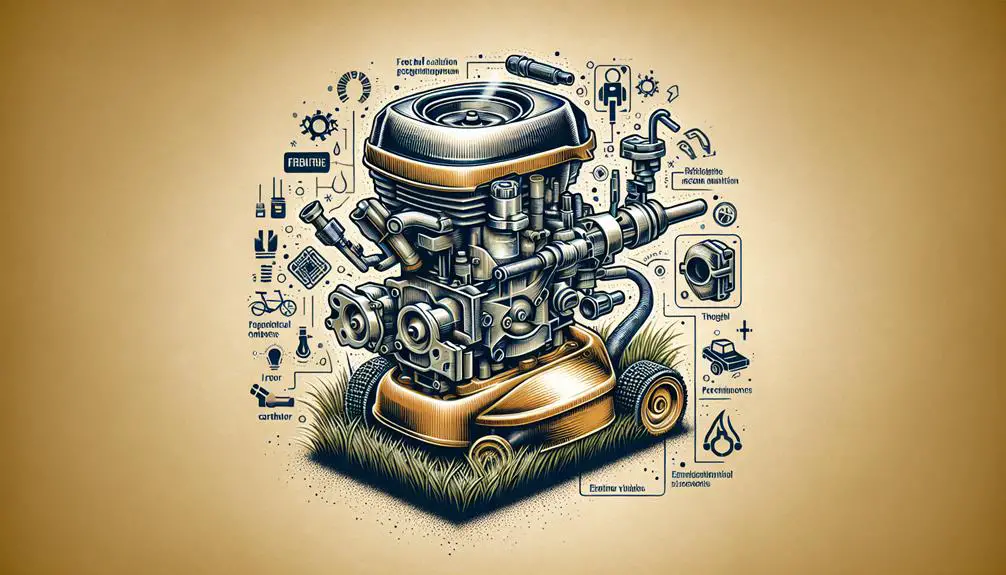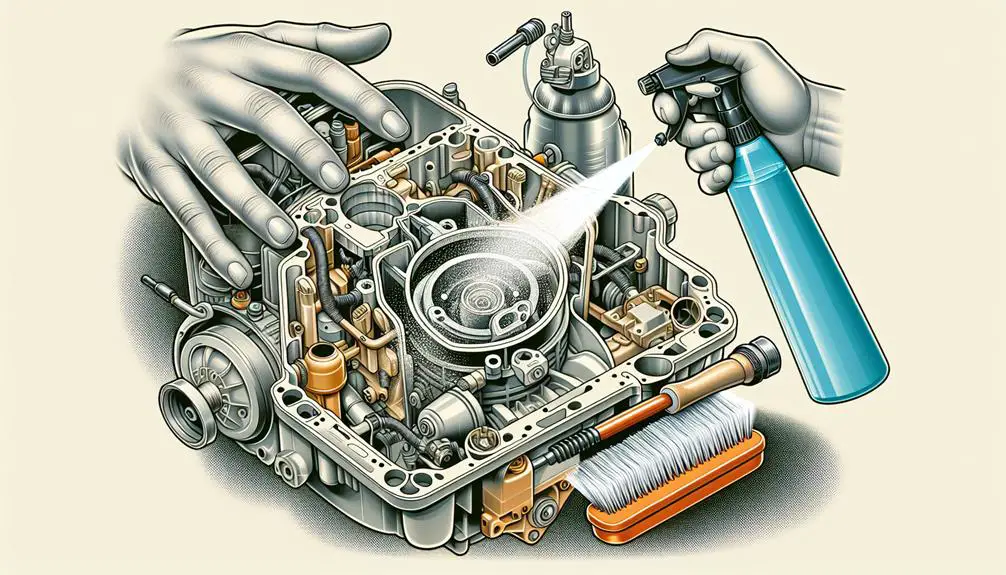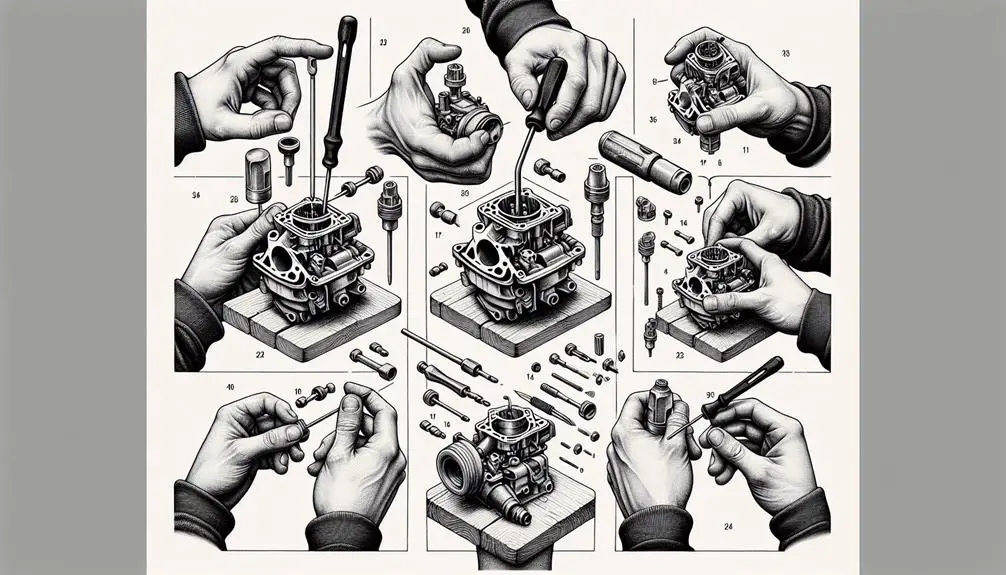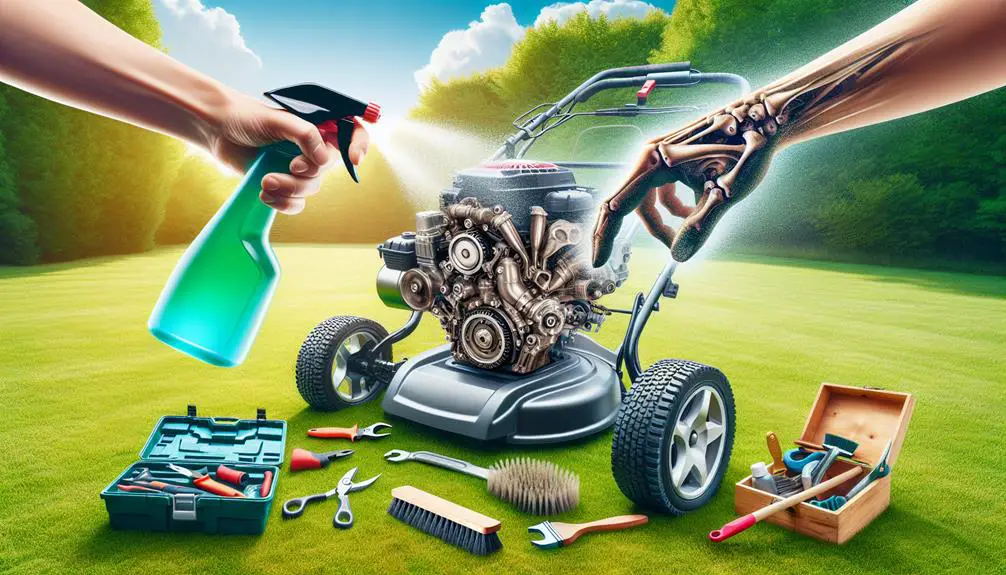To clean a lawn mower carburetor without removing it, start by ensuring the mower is off and cool. Add a carburetor cleaner to the fuel tank, then run the mower to allow the cleaner to circulate through the carburetor, breaking down deposits.
For stubborn areas, use a spray cleaner directly on the exterior parts of the carburetor accessible without removal. Ensure safety by disconnecting the spark plug before starting and work in a well-ventilated area. This method saves time and effort while effectively getting your mower running smoothly again.
Lawn Mower’s Carburetor Overview

To keep your lawn mower working well, it’s important to know about the carburetor and when it might be dirty. The carburetor mixes air and fuel correctly for the engine to run. It has parts like the throttle (controls speed), the choke (helps start the engine when it’s cold), the float chamber (keeps the fuel level steady), and the jets (control fuel flow).
If the carburetor gets dirty, you might notice problems. Signs include the mower being hard to start, running unevenly, or losing power. If the engine only works with the choke on, or if it stops running soon after starting or when under pressure, the carburetor might be blocked.
Keeping the carburetor clean helps the mower use less fuel and pollute less. Watching for these signs helps you maintain your mower and be more eco-friendly.
Preparing to Clean Your Lawn Mower’s Carburetor
Before you start cleaning your lawn mower’s carburetor, you’ll need to take some safety precautions and make the necessary preparations.
Gather all the tools and materials you’ll require for the cleaning process. This ensures you’re ready to tackle the job safely and efficiently.
Safety precautions and necessary preparations
To stay safe and make sure your lawn mower works well after cleaning its carburetor, follow these important steps:
- Turn off the lawn mower and unplug the spark plug to avoid the mower starting by accident.
- Make sure the mower is on a level, stable surface to prevent it from moving and causing injury.
- Wear gloves and glasses to protect against chemicals and debris.
These steps are crucial for your safety and for a successful carburetor cleaning.
Tools and materials needed for the cleaning process
Prepare to clean your lawn mower’s carburetor by gathering the needed tools and materials. This makes the cleaning process smoother since you’ll have everything you need ready.
For a non-removal cleaning, here’s what’s essential:
- Carburetor cleaner spray: It dissolves buildup in the carburetor.
- Safety glasses: They protect your eyes from chemicals and debris.
- Screwdriver: It’s used to remove covers or attachments for easier access to the carburetor.
With these items, you can clean the carburetor effectively and safely.
Step-by-Step Guide to Cleaning the Carburetor Without Removal

Now that you’re prepared, let’s tackle cleaning your lawn mower’s carburetor without having to remove it entirely.
You’ll start by accessing the carburetor, ensuring you have enough room to work around it.
Then, we’ll guide you through inspecting, applying cleaner, and tidying up both the interior and exterior components to get your mower running smoothly again.
Step 1: Accessing the Carburetor
To clean the carburetor without removing it, first make sure the lawn mower is off and has cooled down. Find the air filter housing on the engine, which is held by screws or clips. Remove these to reveal the carburetor. Use a magnetic screwdriver to keep screws from falling in tight spaces. Use a flashlight or headlamp if it’s hard to see. Move any cables or hoses gently without disconnecting them if you don’t have to.
Now, you can clean the carburetor.
Step 2: Inspecting the Carburetor
After opening the carburetor, check it for dirt and debris. Look at the outside for any visible buildup.
Focus on the throttle and choke as they often get dirty and affect performance. You don’t need to dismantle the carburetor to see these areas.
Use a flashlight to check hidden spots for dirt. Clean parts that are dirty and can be reached without taking the carburetor apart.
This step is important for cleaning it properly.
Step 3: Using Carburetor Cleaner
Choose the right carburetor cleaner for your lawn mower by checking if it matches your mower’s engine type, either 2-stroke or 4-stroke. Read labels to find if the cleaner is eco-friendly or strong but may damage rubber and plastic parts.
After selecting the cleaner, wait until the engine cools down. Spray the cleaner into the carburetor, focusing on dirt-prone areas. Use enough cleaner but avoid using too much. Let it sit for minutes to dissolve the dirt, then start the engine to remove the loosened dirt. Repeat if needed, making sure you’re in a place with good air flow to avoid breathing in fumes.
Step 4: Cleaning the Exterior
After cleaning the inside with carburetor cleaner, clean the outside to keep the lawn mower working well. Use a soft brush or cloth to gently remove dirt or grass on the carburetor’s surface. Be careful not to harm sensitive parts or lose small pieces.
For tough dirt, slightly wet the cloth with carburetor cleaner, but not too much to avoid liquid getting inside. Cleaning the outside prevents dirt from entering the carburetor and causing problems. A clean outside is as important as a clean inside.
Step 5: Addressing the Throttle and Choke
Focus on cleaning the throttle and choke without taking them apart. Use carburetor cleaner spray on these parts.
Move the throttle and choke manually to open and close positions while spraying. This helps remove any blockages.
Let the cleaner work for a few minutes, then spray again to clear out any remaining debris.
Start the engine to make sure the cleaner is gone and that the throttle and choke move freely. If they stick, repeat until they work smoothly.
Steps to reassemble any parts that were moved or adjusted

Step 1:
Begin by reinstalling the throttle and choke plates if they were removed during the cleaning process. Ensure they’re correctly aligned within their designated grooves or notches to facilitate smooth operation and avoid any potential sticking issues. If these components were adjusted without removal, verify their alignment according to the manufacturer’s guidelines.
Step 2:
Reattach any springs or linkages that were detached. These components are crucial for maintaining the lawn mower’s appropriate speed and power output. If you documented their original positions through photographs or notes prior to cleaning, refer to these to ensure accurate placement. Incorrect attachment can result in the mower operating inefficiently or failing to start.
Step 3:
Proceed to secure the air filter assembly back in place if it was removed or loosened for carburetor access. Ensure a tight fit to prevent unfiltered air from entering the carburetor, which could cause operational issues in the future.
Step 4:
How to safely test the lawn mower after cleaning the carburetor
To safely test the lawn mower after cleaning the carburetor, follow these steps:
- Work in a well-ventilated area to avoid exhaust fumes buildup. This can be outside or in an open garage.
- Make sure all parts, including the carburetor and air filter, are properly connected. Incorrectly fitted parts can cause issues.
- Check that the fuel tank has fresh fuel. Old fuel can cause starting problems.
- Ensure the spark plug is correctly connected. A disconnected spark plug can stop the engine from starting.
- Before starting, look around to ensure no people, pets, or obstacles are nearby.
- Start the mower as the manufacturer instructs.
If the mower starts smoothly and runs well, the cleaning was successful. If not, you may need more troubleshooting or professional help. Always prioritize safety.
Maintenance Tips to Keep Your Carburetor Clean

Maintaining your lawn mower’s carburetor is important for its performance. Here’s how to keep it clean:
- Use fresh fuel: Old fuel can harm your carburetor. Use new fuel and add a fuel stabilizer if you won’t use it quickly.
- Check the air filter: A clean air filter protects the carburetor. Clean or replace it according to your mower’s manual.
- Clean the mower: Remove grass and mud from the mower after each use to prevent rust and protect the carburetor.
Conclusion
Now that you’ve cleaned your lawn mower’s carburetor without taking it out, your mower should run better.
Remember to put back any parts you moved, and always check if your mower works well in a big, open space.
Doing regular checks and cleanings like this helps keep your mower working well.
With these steps, taking care of your lawn will be easier.